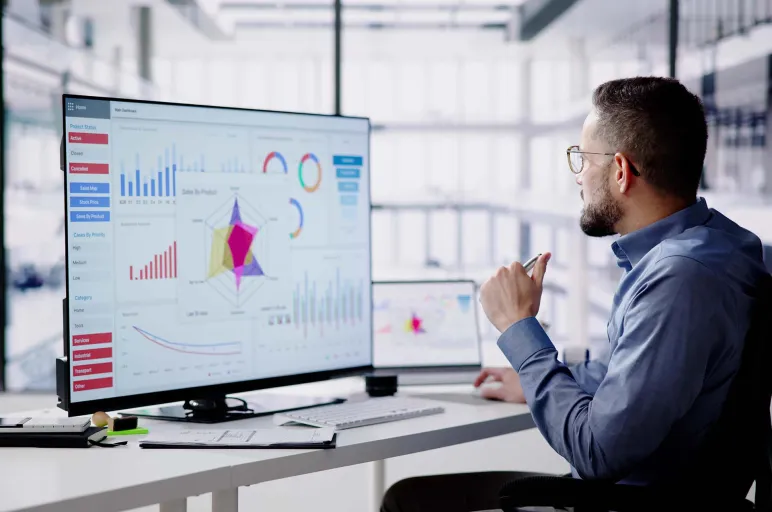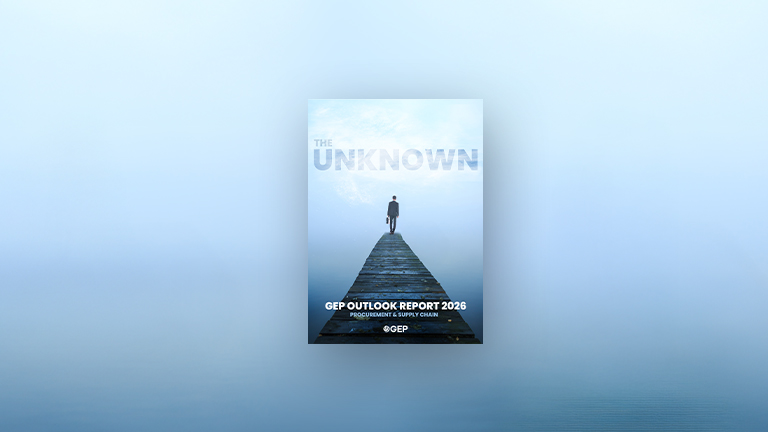
A Procurement Control Tower Gives You Strategic Edge. Here’s Why
- A control tower provides procurement teams a real-time and unified view of complex operations.
- It connects data across systems to optimize sourcing, costs, and supplier performance.
- Teams can proactively manage risk, automate workflows, and drive better procurement outcomes.
August 18, 2025 | Procurement Software 6 minutes read
Procurement is full of risks. This is especially true for multi-enterprise operations, where the level of visibility and control you have can either make or break your procurement strategy.
In complex procurement cycles, what gets measured and monitored early on is what gets managed and improved upon later.
That’s where a procurement control tower comes in.
What is a Procurement Control Tower?
It’s a centralized platform that offers real-time visibility and end-to-end control of all your procurement operations. It can monitor supplier performance, enhance collaboration, automate workflows, curb costs, ensure compliance, and drive smart data-backed decisions.
Talk to our experts
6 Critical Features of a High-Performing Procurement Control Tower
While implementing a smart and dependable solution to digitize your procurement systems is crucial, choosing a system that’s well-suited to the complexity, scale, and personalization you require is even more important.
Consider these as core features of a modern-day control tower:
1. End-to-End Visibility
The main feature of any control tower is its ability to consolidate data from diverse sources to give you a unified view of everything that goes on between global procurement units, suppliers, and third-party vendors.
Your tower displays exactly how data across ERPs, procure-to-pay systems, finance and accounting, supplier portals, banking systems, e-sourcing tools, and other external feeds – in real-time. With it, you easily track silos down from broader global spending and narrow it down to individual purchase orders and invoices.
2. Integration with Supply Chain Control Towers
Global procurement is highly dependent on production schedules, inventory levels, logistics, and evolving customer demand and regulations. This is why the ease of integration of a procurement control tower with the supply chain control tower is crucial to keep procurement operations running smoothly and adapt quickly.
With this integration, you gain a broader understanding of the entire supply chain process beyond procurement. You can also prevent excessive buys and stockouts, re-source or expedite sourcing of critical materials.
3. Predictive Analytics for Deeper Procurement Insights
Using predictive analytics, a procurement control tower analyzes historical data and forecast disruptions like cost spikes and anticipate market dynamics before they hit. Modern control towers that use generative AI can also recommend actionable solutions to help procurement leaders and teams stay ahead of the curve.
As the name suggests, the control tower gives you total control over your day-to-day operations. With advanced data visualization, intuitive dashboards, heatmaps, and interactive charts, you can explore your data from every angle and uncover insights faster.
4. Procurement Automation & Intelligent Operations
A procurement control tower that is cloud-based, scalable, secure, and one that easily integrates with your legacy systems best suits large enterprises. Depending on your needs, you can either choose partial automation or complete source-to-pay cycle automation for maximum efficiency.
While you can implement AI chatbots in the control tower to handle frequent, low-value requests, organizations are now also shifting towards agentic AI systems for their ability to analyze, strategize, and manage complex procurement tasks autonomously.
5. Supplier & Sourcing Management
The control tower can automate supplier sourcing and onboarding. It can issue RFQs to multiple suppliers, track supplier performance and KPIs, and analyze responses in real-time. It also provides enterprises with real-time crisis response capabilities via early alerts and automated qualification of alternative suppliers.
Beyond sourcing, it helps build stronger supplier relationships and drives mutual value by modeling total cost of ownership and value chain optimization opportunities.
6. Collaboration Tools for Smooth Communication
One of the biggest wins of implementing a control tower for your organization is complete transparency and data visibility to all stakeholders. That said, you must be able to control access to information based on account types, roles, and key performance indicators.
A control tower that features shared portals, dashboards, and collaborative workspaces ensures smooth communication between internal cross-functional teams and external stakeholders. It allows for easy review, approval, and direct comments within workflows, speeding up purchase order/sourcing cycles.
One Dashboard, Many Benefits
Often referred to as a single source of truth, a procurement control tower goes beyond being just plain old dashboards. It can transform how you manage costs, risks, and supplier performance.
Effective Multi-Enterprise Collaboration
The control tower ensures smooth multi-enterprise collaboration with timely alerts, quick issue resolution, and shared workspaces for enhanced productivity and communication. This allows for seamless collaboration regardless of time or distance, keeping people and processes aligned, agile, and productive.
Two-Way Information Flow
The tower connects people and systems. Just as users use real-time data from the dashboards, they also feed information in the form of updates back into the system in real time. This creates a cycle of feeding and pulling information, keeping data updated at all times, both from the system and the users.
Intelligent Cost Reduction
With an advanced control tower, procurement teams can detect duplicate orders or rogue spend to control costs. It can also analyze market fluctuations, find contractual gaps, promote negotiations, and offer recommendations to enhance profitability and manage budgets effectively.
Procurement Workflow Automation
Workflow automation in a procurement control tower covers the entire source-to-pay cycle and automates tasks like purchase requests, approvals, vendor selection, order tracking, and invoice processing. It can also integrate with other systems like ERPs and a supply chain control tower to automate specific routine tasks.
Self-service procurement (SSP) is another benefit that you can get with a control tower. With this, procurement teams can manage their own purchase requests, reducing interdependence on other departments, leading to faster turnaround times.
Optimized Functionality of Existing Systems
The control tower’s ability to integrate with all internal and external systems into a centralized system leads to controlled procurement with complete transparency. This reduces the chances of erroneous data and data duplication.
The tower operates in a cloud-native environment, leading to faster and safer access to data and storage. Its regular data cleansing and optimization allow all systems to track, analyze, and report from a single source, boosting performance and reliability.
Strengthen Supplier Networks Against Risks and Uncertainty
Large enterprises often deal with a large database of suppliers and vendors. The control tower alerts suppliers about potential risks and lets them track shipment statuses for timely deliveries.
Even during emergencies, it can help procurement teams identify savings opportunities and streamline supplier onboarding through automated compliance verification and contract generation. It also flags inadequate or excessive inventory and operational inefficiencies.
101 AI Use Cases in Procurement
Find proven and emerging AI applications across the S2P cycle
The Right Way to Implement a Procurement Control Tower
A successful implementation depends on a clear strategy, strong data, and company-wide buy-in. That’s why it’s essential to follow the right steps before you get started.
1. Set Clear Goals
Clearly define your short-term and long-term goals and ensure that it’s aligned with the overall business goals of the organization. Analyze existing gaps in your current procurement process and how you plan to address them.
Prioritize areas of maximum impact to reach your goals and the resources required. You can then define KPIs like cost reductions, on-time delivery rates, supplier growth rate, approval times, supplier KPIs, customer-centric KPIs, automation rate, budget allocation, ESG compliance, etc.
2. Assess Data Readiness and Quality
Ensure that your databases are cleaned and ready for use. The success of predictive analytics heavily depends on the quality and amount of data fed into it. So, take your time and conduct a thorough analysis of your existing data.
3. Choose the Right Technology Partner
Implementing a procurement control tower is no small undertaking — it takes time, effort, and a thoughtful approach to get it to where you want it to be.
Choose the right technology provider who can truly understand your needs. Ensure that they are reliable, experienced, and offer great post-sales implementation and support.
4. Promote a Data-Driven Culture Across Teams
Prepare your teams for the move. Establish detailed training programs for all the internal and external stakeholders of the organization. Ensure that team leaders are well-experienced with the tools before it is introduced to the teams. A great way to improve acceptance is to explain the benefits of implementing a control tower and introduce KPIs that encourage the move.
5. Pilot and Test the Control Tower
Start with small focus groups across departments and locations to test your control tower on a pilot project. Provide role-based access from senior management to frontline staff and suppliers, and train key users to drive adoption. Work closely with your tech provider during this phase to evaluate their support before you ‘seal the deal’.
6. Continuously Monitor and Optimize Performance
Build a framework to evaluate control tower performance post-implementation. Implement timely feedback mechanisms to understand the general receptivity towards the change. Prioritize feedback that directly impacts productivity and performance. Keep iterating, and track KPIs weekly, monthly, and quarterly to drive accountability.
Single Source of Truth
Given that all your operations will rely on control tower as a single source of truth, it’s critical that you and your technology partner are fully aligned from the start. A well-implemented procurement control tower gives you the ability to anticipate disruptions, respond proactively, and turn supplier relationships into strategic drivers of growth.



